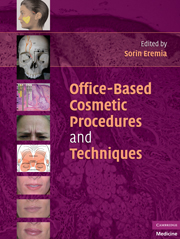Book contents
- Frontmatter
- Contents
- PREFACE
- CONTRIBUTORS
- PART ONE ANATOMY AND THE AGING PROCESS
- PART TWO ANESTHESIA AND SEDATION FOR OFFICE COSMETIC PROCEDURES
- PART THREE FILLERS AND NEUROTOXINS
- Chap. 6 FILLERS: PAST, PRESENT, AND FUTURE
- Chap. 7 HYALURONIC ACID FILLERS: HOW STRUCTURE AFFECTS FUNCTION
- Chap. 8 RESTYLANE: GENERAL CONCEPTS
- Chap. 9 THE RESTYLANE FAMILY OF FILLERS: CANADIAN EXPERIENCE
- Chap. 10 THE JUVÉDERM FAMILY OF FILLERS
- Chap. 11 PURAGEN: A NEW DERMAL FILLER
- Chap. 12 PURAGEN: ASIAN EXPERIENCE
- Chap. 13 REVIEW OF COLLAGEN FILLERS
- Chap. 14 HUMAN AND BOVINE COLLAGEN-BASED FILLERS
- Chap. 15 PORCINE COLLAGEN: EVOLENCE
- Chap. 16 CALCIUM HYDROXYLAPATITE (RADIESSE): A FACIAL PLASTIC SURGEON'S APPROACH
- Chap. 17 CALCIUM HYDROXYLAPATITE (RADIESSE): A DERMASURGEON'S APPROACH
- Chap. 18 CALCIUM HYDROXYLAPATITE FOR HAND VOLUME RESTORATION
- Chap. 19 LONG-LASTING FILLERS: HOW STRUCTURE AFFECTS FUNCTION
- Chap. 20 ACRYLIC PARTICLE–BASED FILLERS: ARTEFILL
- Chap. 21 POLY-L-LACTIC ACID FILLERS
- Chap. 22 POLY-L-LACTIC ACID (SCULPTRA) FOR HAND VOLUME RESTORATION
- Chap. 23 BIOALKAMIDE
- Chap. 24 SILICONE
- Chap. 25 AUTOLOGOUS FAT TRANSFER: AN INTRODUCTION
- Chap. 26 SMALL-VOLUME FAT TRANSFER
- Chap. 27 LARGER-VOLUME FAT TRANSFER
- Chap. 28 FAMI TECHNIQUE AND FAT TRANSFER FOR HAND REJUVENATION
- Chap. 29 ADDING VOLUME TO THE AGING FACE: FAT GRAFTING VERSUS FILLERS AND IMPLANTS IN EUROPE
- Chap. 30 FILLERS: HOW WE DO IT
- Chap. 31 CHOOSING A FILLER
- Chap. 32 FILLER COMPLICATIONS
- Chap. 33 NEUROTOXINS: PAST, PRESENT, AND FUTURE
- Chap. 34 BOTOX: HOW WE DO IT
- Chap. 35 COSMETIC BOTOX: HOW WE DO IT
- Chap. 36 BOTOX: BEYOND THE BASICS
- Chap. 37 BOTOX FOR HYPERHIDROSIS
- Chap. 38 DYSPORT
- Chap. 39 NEUROTOXIN ALTERNATIVE: RADIOFREQUENCY CORRUGATOR DENERVATION
- Chap. 40 FILLERS AND NEUROTOXINS IN ASIA
- Chap. 41 FILLERS AND NEUROTOXINS IN SOUTH AMERICA
- PART FOUR COSMETIC APPLICATIONS OF LIGHT, RADIOFREQUENCY, AND ULTRASOUND ENERGY
- PART FIVE OTHER PROCEDURES
- INDEX
- References
Chap. 26 - SMALL-VOLUME FAT TRANSFER
from PART THREE - FILLERS AND NEUROTOXINS
Published online by Cambridge University Press: 06 July 2010
- Frontmatter
- Contents
- PREFACE
- CONTRIBUTORS
- PART ONE ANATOMY AND THE AGING PROCESS
- PART TWO ANESTHESIA AND SEDATION FOR OFFICE COSMETIC PROCEDURES
- PART THREE FILLERS AND NEUROTOXINS
- Chap. 6 FILLERS: PAST, PRESENT, AND FUTURE
- Chap. 7 HYALURONIC ACID FILLERS: HOW STRUCTURE AFFECTS FUNCTION
- Chap. 8 RESTYLANE: GENERAL CONCEPTS
- Chap. 9 THE RESTYLANE FAMILY OF FILLERS: CANADIAN EXPERIENCE
- Chap. 10 THE JUVÉDERM FAMILY OF FILLERS
- Chap. 11 PURAGEN: A NEW DERMAL FILLER
- Chap. 12 PURAGEN: ASIAN EXPERIENCE
- Chap. 13 REVIEW OF COLLAGEN FILLERS
- Chap. 14 HUMAN AND BOVINE COLLAGEN-BASED FILLERS
- Chap. 15 PORCINE COLLAGEN: EVOLENCE
- Chap. 16 CALCIUM HYDROXYLAPATITE (RADIESSE): A FACIAL PLASTIC SURGEON'S APPROACH
- Chap. 17 CALCIUM HYDROXYLAPATITE (RADIESSE): A DERMASURGEON'S APPROACH
- Chap. 18 CALCIUM HYDROXYLAPATITE FOR HAND VOLUME RESTORATION
- Chap. 19 LONG-LASTING FILLERS: HOW STRUCTURE AFFECTS FUNCTION
- Chap. 20 ACRYLIC PARTICLE–BASED FILLERS: ARTEFILL
- Chap. 21 POLY-L-LACTIC ACID FILLERS
- Chap. 22 POLY-L-LACTIC ACID (SCULPTRA) FOR HAND VOLUME RESTORATION
- Chap. 23 BIOALKAMIDE
- Chap. 24 SILICONE
- Chap. 25 AUTOLOGOUS FAT TRANSFER: AN INTRODUCTION
- Chap. 26 SMALL-VOLUME FAT TRANSFER
- Chap. 27 LARGER-VOLUME FAT TRANSFER
- Chap. 28 FAMI TECHNIQUE AND FAT TRANSFER FOR HAND REJUVENATION
- Chap. 29 ADDING VOLUME TO THE AGING FACE: FAT GRAFTING VERSUS FILLERS AND IMPLANTS IN EUROPE
- Chap. 30 FILLERS: HOW WE DO IT
- Chap. 31 CHOOSING A FILLER
- Chap. 32 FILLER COMPLICATIONS
- Chap. 33 NEUROTOXINS: PAST, PRESENT, AND FUTURE
- Chap. 34 BOTOX: HOW WE DO IT
- Chap. 35 COSMETIC BOTOX: HOW WE DO IT
- Chap. 36 BOTOX: BEYOND THE BASICS
- Chap. 37 BOTOX FOR HYPERHIDROSIS
- Chap. 38 DYSPORT
- Chap. 39 NEUROTOXIN ALTERNATIVE: RADIOFREQUENCY CORRUGATOR DENERVATION
- Chap. 40 FILLERS AND NEUROTOXINS IN ASIA
- Chap. 41 FILLERS AND NEUROTOXINS IN SOUTH AMERICA
- PART FOUR COSMETIC APPLICATIONS OF LIGHT, RADIOFREQUENCY, AND ULTRASOUND ENERGY
- PART FIVE OTHER PROCEDURES
- INDEX
- References
Summary
Fat transplantation can be used to fill subcutaneous defects ranging in size from major to minor. Today, many patients are interested in ambulatory procedures with minimal downtime. Small-volume fat transplantation can easily be performed under local anesthesia, allowing the patient to return to public life within one or two days. Although the term may mean different things to different surgeons, small-volume fat transplantation might include augmentation of the malar, nasojugal, and nasolabial areas. These minor lipoaugmentation procedures can be repeated monthly or bimonthly, eventually leading to a significant improvement with minimal time dedicated to recovery.
Small-volume fat transplantation can be performed all over the body but is most commonly used for facial atrophy due to trauma and aging or for traumatic fat dents of the thighs resulting from liposuction or accidents. It is also useful for augmentation of aging hands. Since several small-volume procedures are needed to obtain the best results, patients must be forewarned that they will often see minimal improvement after the first procedure. Augmentation of subcutaneous defects also requires many times the volume of augmentation of cutaneous defects. The comparatively dense dermis requires very little filling volume to achieve a visual improvement, compared to subcutaneous tissue, which often seems to act as a black hole, soaking up filling materials. The physician who moves from injecting dermal fillers into using subcutaneous fillers learns this very quickly.
Small-volume fat transplantation can also be used as part of a combination approach.
- Type
- Chapter
- Information
- Office-Based Cosmetic Procedures and Techniques , pp. 110 - 113Publisher: Cambridge University PressPrint publication year: 2010



